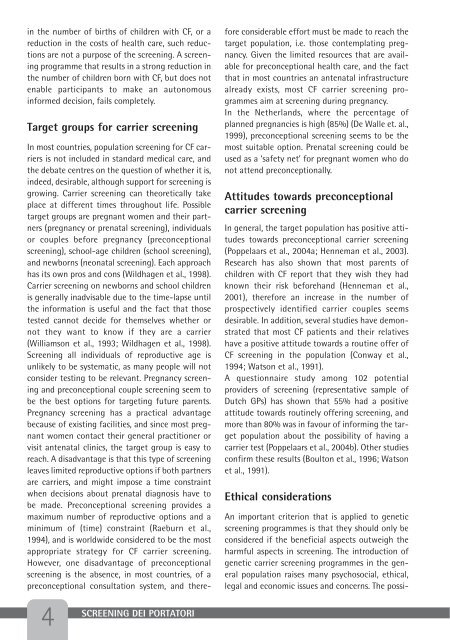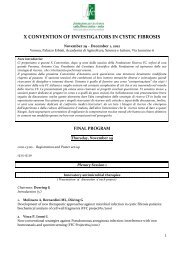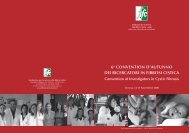Brochure Seminario di Primavera 2005 - Fondazione Ricerca ...
Brochure Seminario di Primavera 2005 - Fondazione Ricerca ...
Brochure Seminario di Primavera 2005 - Fondazione Ricerca ...
You also want an ePaper? Increase the reach of your titles
YUMPU automatically turns print PDFs into web optimized ePapers that Google loves.
in the number of births of children with CF, or a<br />
reduction in the costs of health care, such reductions<br />
are not a purpose of the screening. A screening<br />
programme that results in a strong reduction in<br />
the number of children born with CF, but does not<br />
enable participants to make an autonomous<br />
informed decision, fails completely.<br />
Target groups for carrier screening<br />
In most countries, population screening for CF carriers<br />
is not included in standard me<strong>di</strong>cal care, and<br />
the debate centres on the question of whether it is,<br />
indeed, desirable, although support for screening is<br />
growing. Carrier screening can theoretically take<br />
place at <strong>di</strong>fferent times throughout life. Possible<br />
target groups are pregnant women and their partners<br />
(pregnancy or prenatal screening), in<strong>di</strong>viduals<br />
or couples before pregnancy (preconceptional<br />
screening), school-age children (school screening),<br />
and newborns (neonatal screening). Each approach<br />
has its own pros and cons (Wildhagen et al., 1998).<br />
Carrier screening on newborns and school children<br />
is generally inadvisable due to the time-lapse until<br />
the information is useful and the fact that those<br />
tested cannot decide for themselves whether or<br />
not they want to know if they are a carrier<br />
(Williamson et al., 1993; Wildhagen et al., 1998).<br />
Screening all in<strong>di</strong>viduals of reproductive age is<br />
unlikely to be systematic, as many people will not<br />
consider testing to be relevant. Pregnancy screening<br />
and preconceptional couple screening seem to<br />
be the best options for targeting future parents.<br />
Pregnancy screening has a practical advantage<br />
because of existing facilities, and since most pregnant<br />
women contact their general practitioner or<br />
visit antenatal clinics, the target group is easy to<br />
reach. A <strong>di</strong>sadvantage is that this type of screening<br />
leaves limited reproductive options if both partners<br />
are carriers, and might impose a time constraint<br />
when decisions about prenatal <strong>di</strong>agnosis have to<br />
be made. Preconceptional screening provides a<br />
maximum number of reproductive options and a<br />
minimum of (time) constraint (Raeburn et al.,<br />
1994), and is worldwide considered to be the most<br />
appropriate strategy for CF carrier screening.<br />
However, one <strong>di</strong>sadvantage of preconceptional<br />
screening is the absence, in most countries, of a<br />
preconceptional consultation system, and there-<br />
4<br />
SCREENING DEI PORTATORI<br />
fore considerable effort must be made to reach the<br />
target population, i.e. those contemplating pregnancy.<br />
Given the limited resources that are available<br />
for preconceptional health care, and the fact<br />
that in most countries an antenatal infrastructure<br />
already exists, most CF carrier screening programmes<br />
aim at screening during pregnancy.<br />
In the Netherlands, where the percentage of<br />
planned pregnancies is high (85%) (De Walle et. al.,<br />
1999), preconceptional screening seems to be the<br />
most suitable option. Prenatal screening could be<br />
used as a ‘safety net’ for pregnant women who do<br />
not attend preconceptionally.<br />
Attitudes towards preconceptional<br />
carrier screening<br />
In general, the target population has positive attitudes<br />
towards preconceptional carrier screening<br />
(Poppelaars et al., 2004a; Henneman et al., 2003).<br />
Research has also shown that most parents of<br />
children with CF report that they wish they had<br />
known their risk beforehand (Henneman et al.,<br />
2001), therefore an increase in the number of<br />
prospectively identified carrier couples seems<br />
desirable. In ad<strong>di</strong>tion, several stu<strong>di</strong>es have demonstrated<br />
that most CF patients and their relatives<br />
have a positive attitude towards a routine offer of<br />
CF screening in the population (Conway et al.,<br />
1994; Watson et al., 1991).<br />
A questionnaire study among 102 potential<br />
providers of screening (representative sample of<br />
Dutch GPs) has shown that 55% had a positive<br />
attitude towards routinely offering screening, and<br />
more than 80% was in favour of informing the target<br />
population about the possibility of having a<br />
carrier test (Poppelaars et al., 2004b). Other stu<strong>di</strong>es<br />
confirm these results (Boulton et al., 1996; Watson<br />
et al., 1991).<br />
Ethical considerations<br />
An important criterion that is applied to genetic<br />
screening programmes is that they should only be<br />
considered if the beneficial aspects outweigh the<br />
harmful aspects in screening. The introduction of<br />
genetic carrier screening programmes in the general<br />
population raises many psychosocial, ethical,<br />
legal and economic issues and concerns. The possi-

















